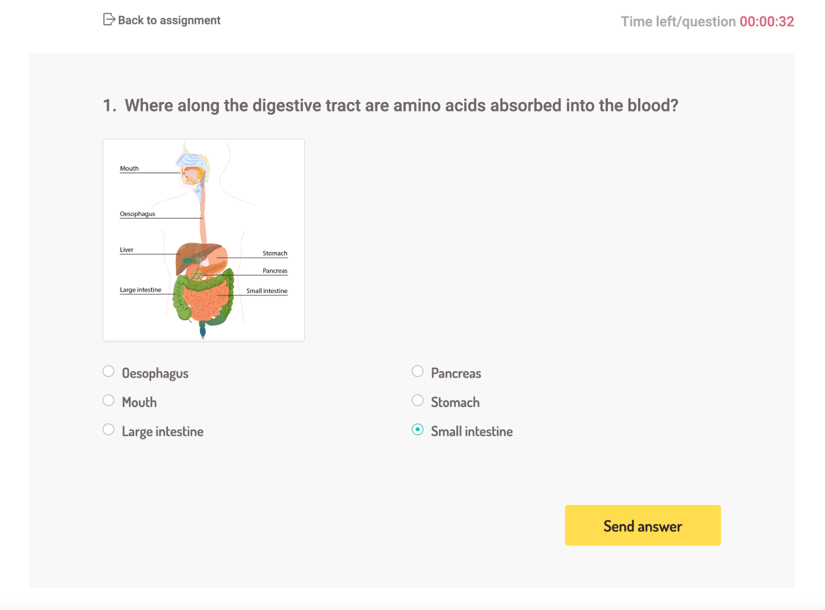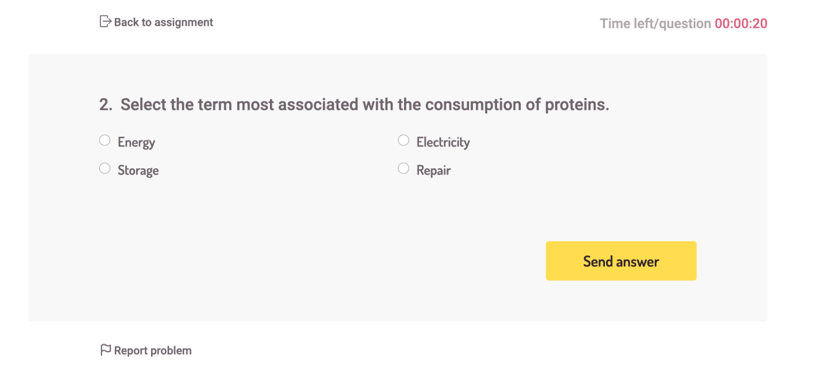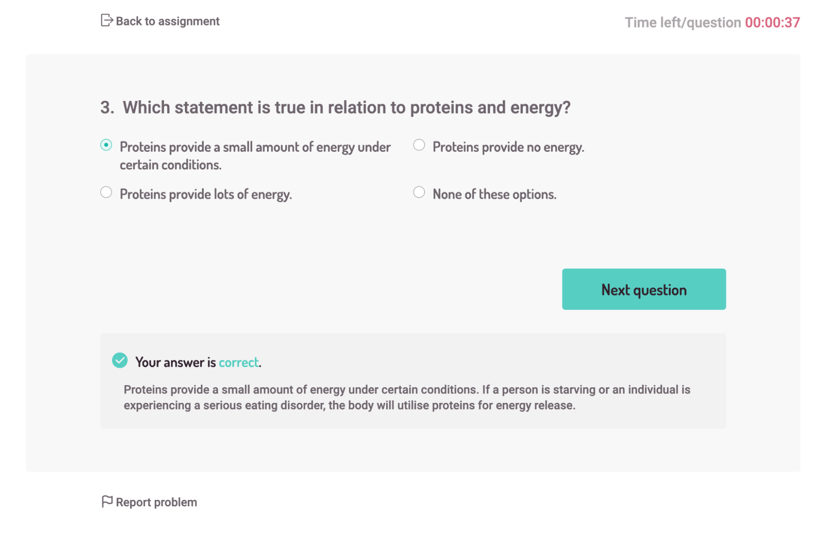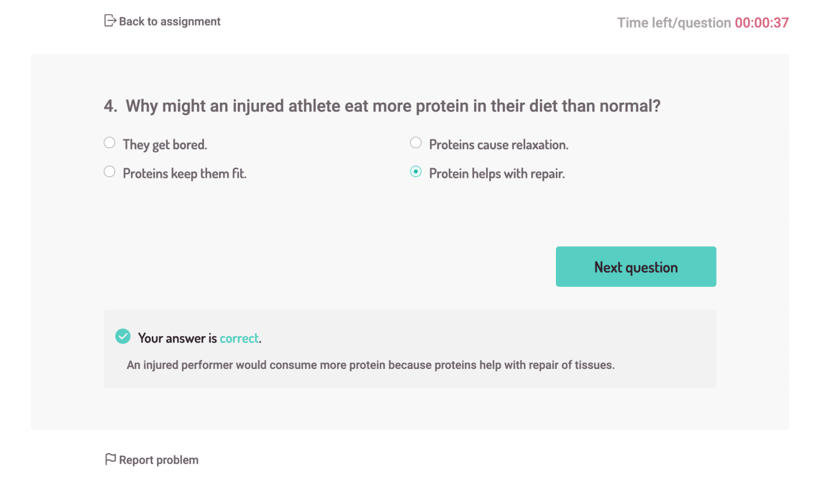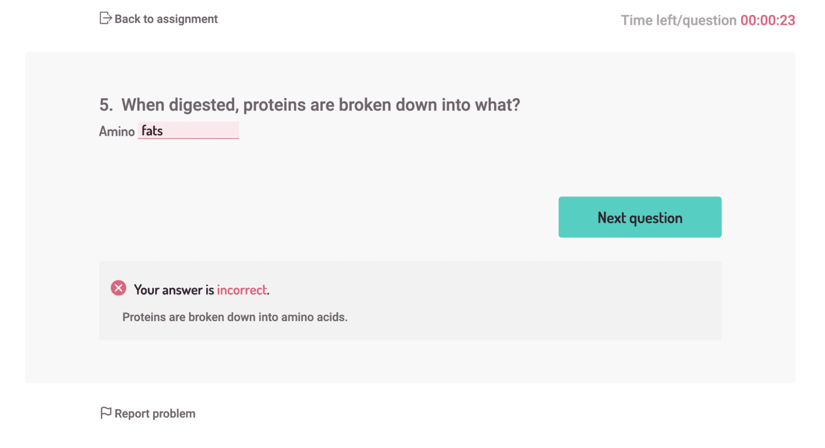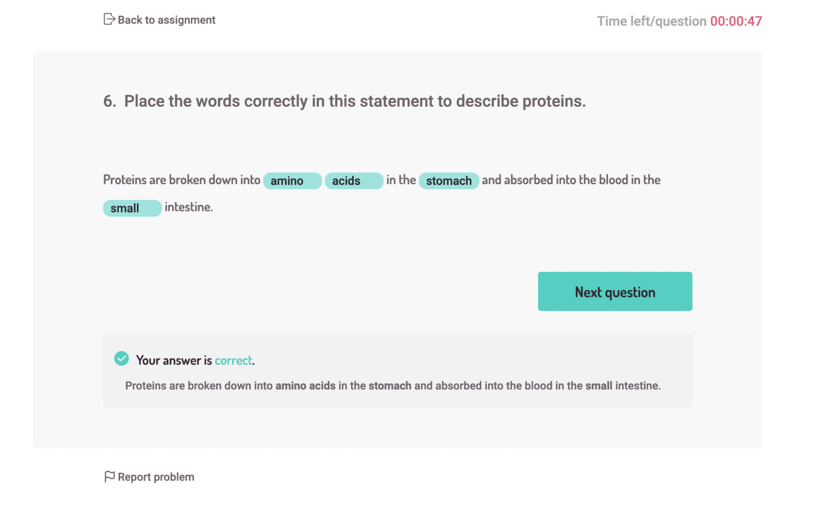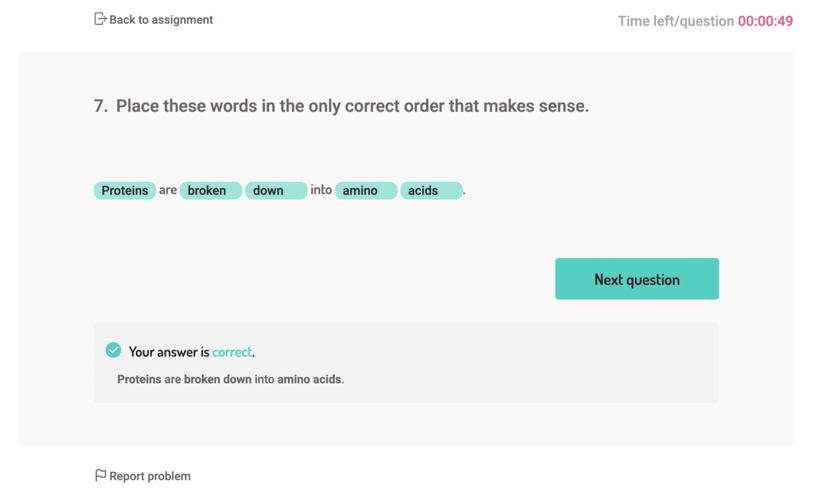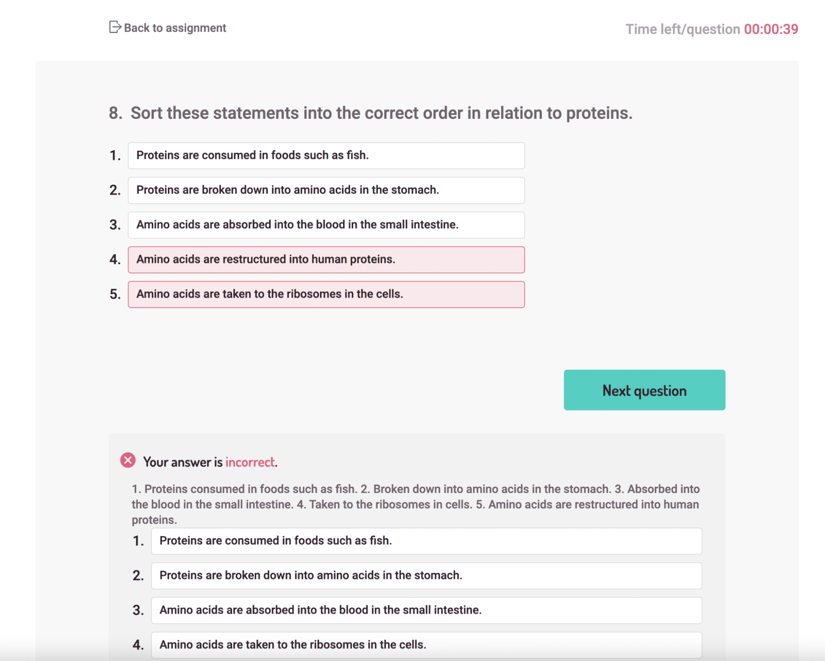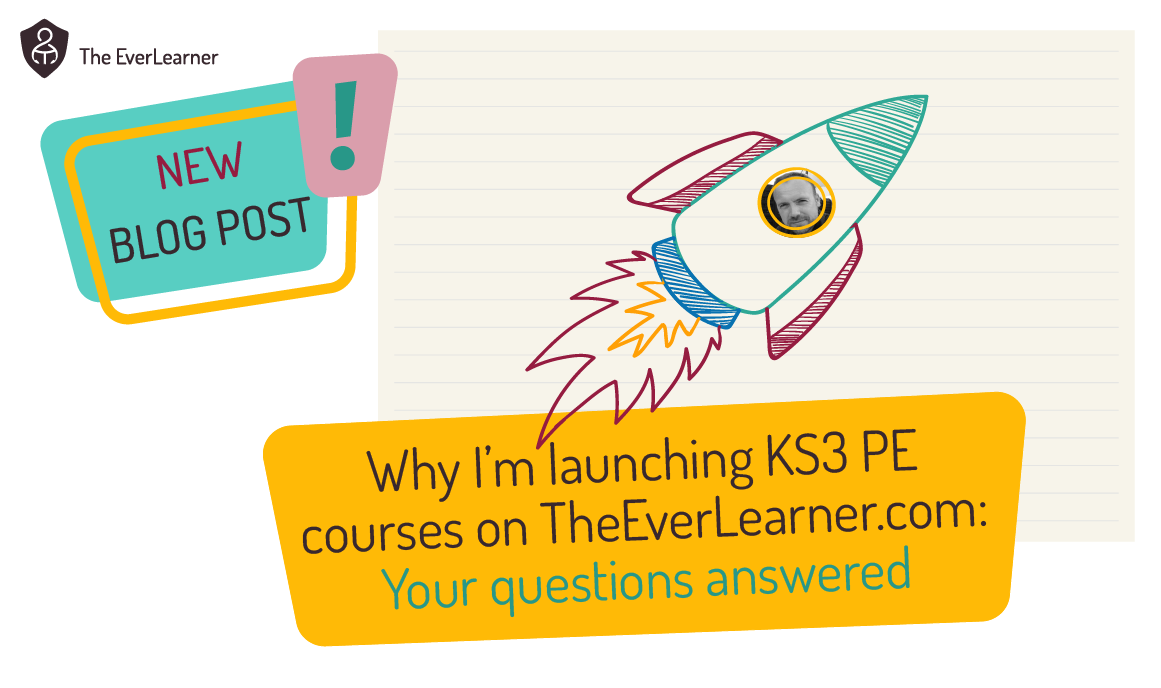I’ve still got it… I think! Two of my recent KS3 PE lessons for you to review!!
Thank you for visiting my blog.
Those of you who know me will know that I specialise in academic PE teaching. My career experience has spanned 22 years of PE teaching and 10 of those years were as a Head of PE in a specialist sixth form college with the biggest A-level PE cohorts that have ever existed. Therefore, I have taught thousands of academic PE lessons.
But I am also a practical PE teacher. I qualified via PGCE in 1999 and have worked in four different state secondary schools as well as the sixth form college previously mentioned. Across these roles, I have taught thousands of practical PE lessons spanning every activity. A games player at heart, I have taught everything from dance to gymnastics. From swimming to OAA. From Ultimate Frisbee to trampolining. From lacrosse to health and fitness. From rugby league to table tennis. In my own view, I am not a “special” practical PE teacher. I am capable but I believe that it is not my “super power”. I consider myself competent but untalented when it comes to teaching practical PE. I’m simply willing to give everything a go.
However, I am good at communication and delivering a message and this is a central theme of my practical PE teaching.
I have previously defined education as doing whatever it takes to derive the maximum possible learning in the broadest possible set of skills that is relevant to a society. For this reason, I strongly believe that learning through movement has the potential to be far broader than learning simply how to move, although movement must be the central pillar upon which any PE lesson is built.
As my career has become increasingly office-based, I have tried to keep my hand in with practical teaching. I do the same with theory-based PE teaching. For these reasons, I have chosen to share a pair of lessons that I have worked on and delivered recently. These lessons are not based on any individual curriculum model but are, rather, lessons that I believe in and feel I wish to share. Some of you will find new ideas contained in the lessons and others will find older ideas. Let’s be honest: I am a 46-year-old PE teacher who qualified in 1999… I’m probably not going to reinvent the wheel here. I am sharing them simply to share. I am not ideological about the lessons. I know they are not perfect (what is?) and I simply wish to add to the conversation.
As you view my lessons, consider feeding back to me what your impressions are. I am genuinely seeking feedback and observation 😊. It’s also a long time since I had a practical PE lesson peer observed/assessed, so I am interested to read/hear what you have to say.
Rather than showing you my lesson plans and how they relate to a scheme of work (I have written neither) I am simply going to provide a chronology of the experiences I provided. Hopefully, this will allow you to understand what I did.
About the group I am working with:
| School | State school in West Surrey |
| Year group | 8 |
| Time of year | Late June |
| Number of students | Approx 24 |
| Gender | Mixed |
My lesson objectives (across two lessons)
- Develop a knowledge of proteins and their use in recovery, adaptation and energy release. Help the student to link these ideas between PE and biology.
- Provide an opportunity for mathematical skills (the median) to be used and applied within a movement context.
- Develop leadership, communication and organisational skills in order to meet an objective as a group.
- Develop a knowledge of how muscles contract to cause movement of the skeleton when running.
These ideas are to be learned through the following movement experiences:
- Sprinting techniques
- Bend running techniques
- Relay techniques
Main foci:
- Proteins
- Leadership, communication and organisational skills
- Sprinting technique
Pre-lesson homework
Students study the lesson on the role of proteins on TheEverLearner.com and master an eight-question quiz. This was a task set over seven days with the highest standards set for students completing their work and meeting the desired performance.
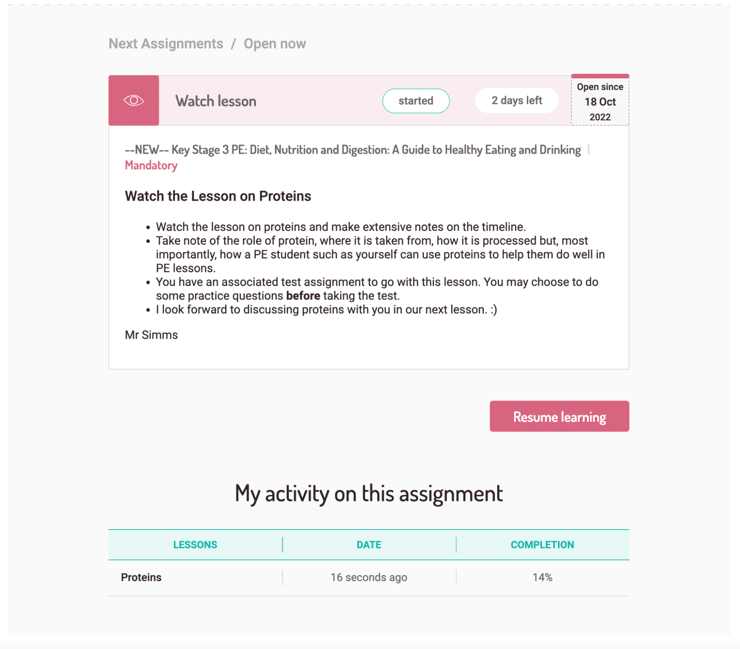
A screen grab of the Watching Assignment that I set. Please note the specific instructions I provide the students.
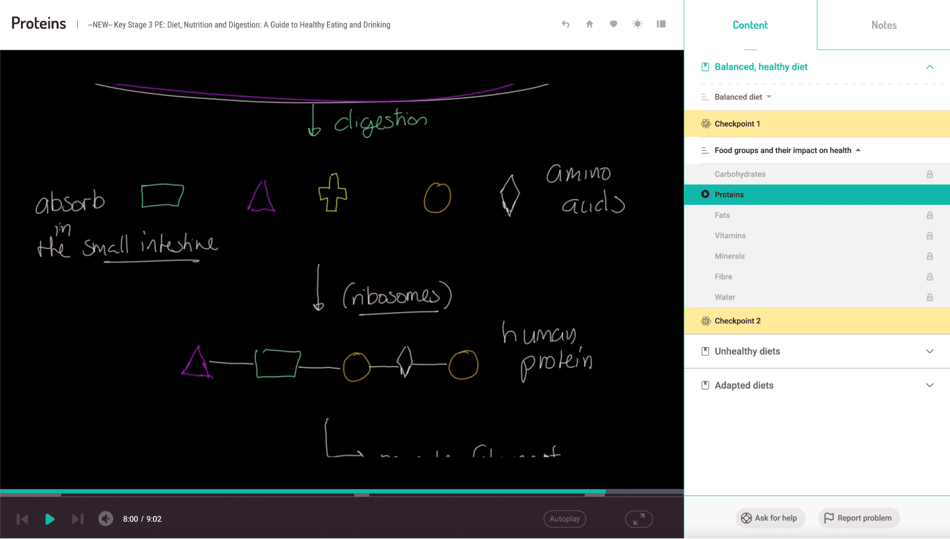 The video that the students watched to complete the assignment. Click the image to watch the video.
The video that the students watched to complete the assignment. Click the image to watch the video.
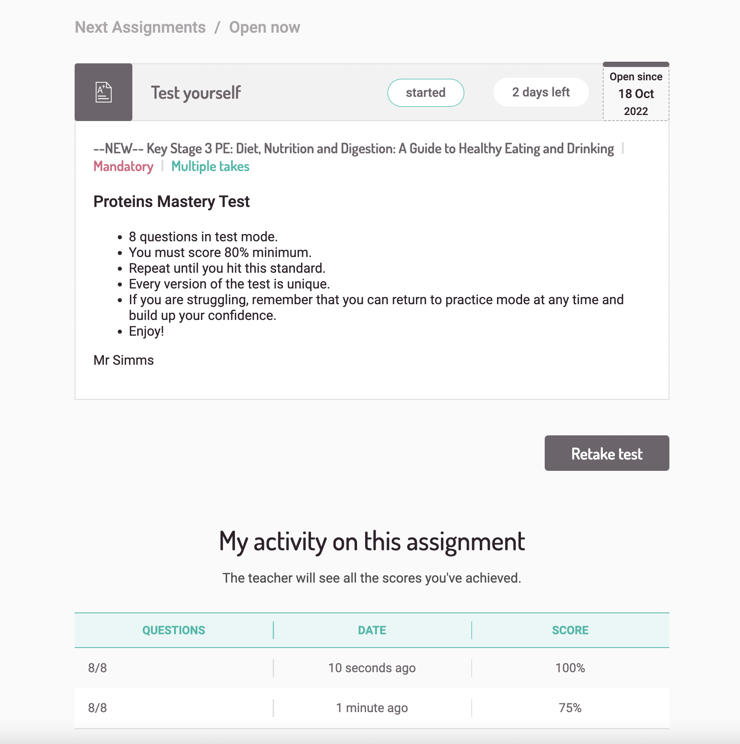 The quiz mastery assignment that one student has taken two attempts to master.
The quiz mastery assignment that one student has taken two attempts to master.
A run of eight questions that a student received. Please note that every quiz iteration is unique.
Activity 1: Warm-up
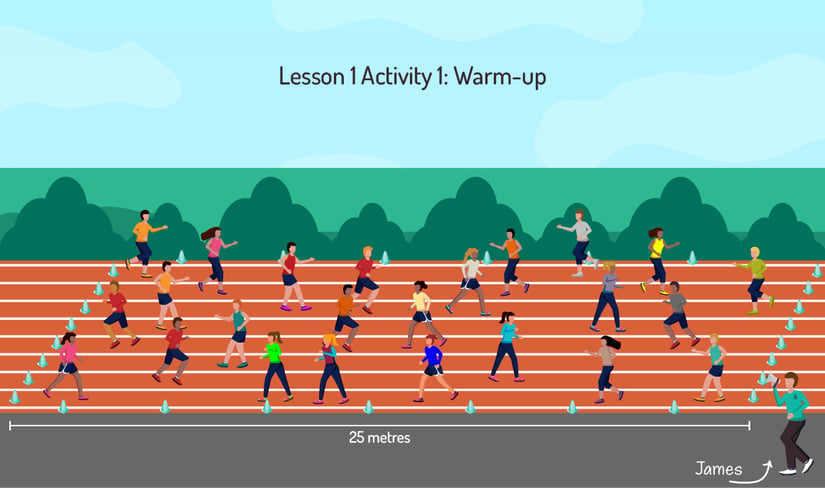
- Working area (WA) as 25m x 8 lanes of running track. Area must be on the straight.
- Students move around WA following commands from James.
- Increase intensity gradually.
- Introduce sprinting isolation movements before returning to move.
- Stretch. Focus on hip flexors and the gluteals but stretch the whole body.
Activity 2: Sprinting game
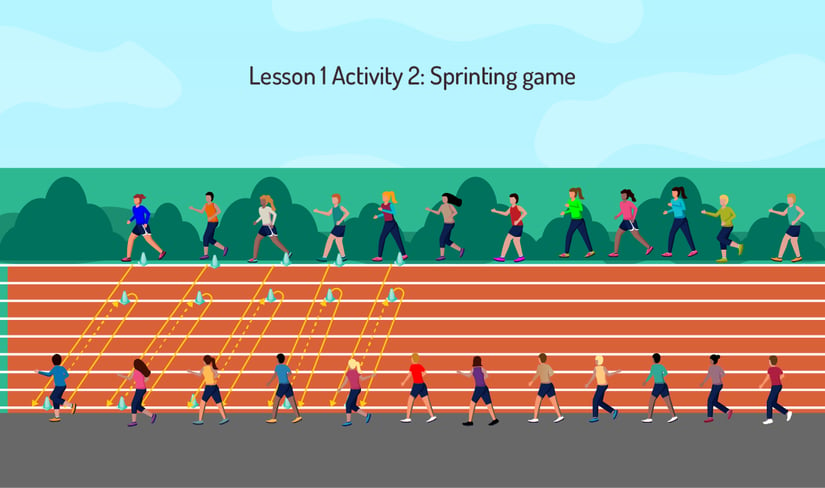
- Tell the students that you will not “set the scene” yet. Simply that we will be working on some sprinting drills.
- Students face a partner each on the edge of the running track.
- Partner A approaches B.
- B is permitted to chase A once A touches the penultimate lane.
- A and B race to cross 8th lane.
- Repeat in the region of three times before switching roles and repeating
Debrief
Take the opportunity to make the follow points:
- To accelerate quickly, get low.
- Apply force to the ground (block) with both feet.
- The turning participant should turn their head first and get low to accelerate.
- Never give up on the race even if you are behind. You never know what might happen in the last few metres.
- Dip for the line.
Activity 3: 20m Group sprint
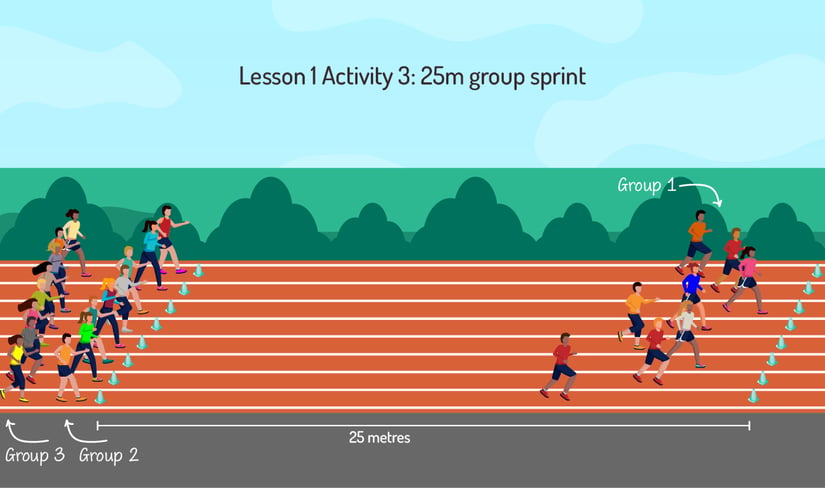
- Break the group into three groups of eight. Ensure that the groups are as randomly mixed as possible. This activity needs participants who are faster and slower in each group.
- Group 1 lines up on the (eight-lane) start line. Ask them to run as fast as possible through 20m. Once done, provide the group the time of the last person across the line. If the time is 4.2s, tell them the next go, the entire group must cross the line no later than 3.5s. This challenges the group to discuss sprinting technique and acceleration skills. Encourage them to peer coach and problem solve.
- Repeat with group 2 and 3.
- As group 1 repeats, give the time of the last participant again. It will have improved but is unlikely to be 3.5s yet. Ensure that the group knows it is collectively responsible. Quash any reference to individual performance.
- Once each group has attempted twice, tell all groups they have two further attempts. Coach the sprint start technique as well as reinforcing the acceleration teaching points.
- Two further attempts at achieving the times. Try to “manage” each group to success. This may involve starting the stopwatch slightly later 😉.
Debrief
- Bring the group together and discuss the activity. Stress that the group has been performing high intensity work and that this work is likely to cause microscopic muscle damage. Bring proteins into the conversation and their role as a recovery agent for this session. Use Q&A to derive the following outputs from the tutorial/quizzing:
- Eating protein within 60 mins of the session.
- Approximately 30g of protein as a portion.
- Discuss the source of protein.
- Ask the group whether protein powered their sprinting. They should tell you it didn’t.
- Ask them when proteins would be used for energy.
- They should tell you when there is no availability of glucose or fat such as in very extreme conditions or starvation. This is an opportunity to mention eating disorders and specifically anorexia nervosa. Do so cautiously and with accurate language. Students have the opportunity to study eating disorders in the future.
Main activity: Whole-group 800m challenge
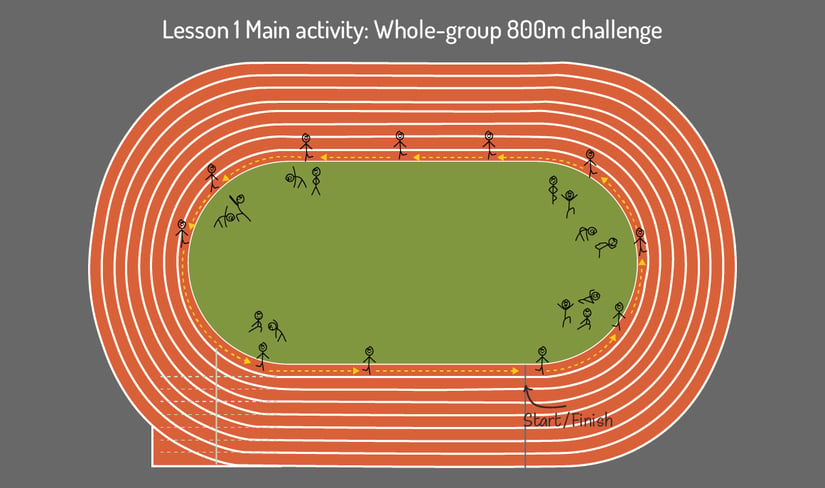
- Take the group to the running track start line.
- Tell them the following challenge:
- Your group must carry the baton around 800m of the track (two laps). If the group is very large you could split it in two and have two batons.
- Every person in the group must run/walk/wheel at least once.
- Each person can run as short or long a distance as the group decides.
- People can run more than one leg if the group decides.
- Give three minutes of planning time.
- Attempt the activity and record the time.
- Ask the group to repeat the activity and challenge them to knock off a proportion of time that you think is SMART from the time.
- Encourage them to discuss and plan their second attempt.
- Where possible, teach principles of handovers, acceleration and bend running.
- Repeat and record the time. Tell the group where their time sits in relation to other Year 8 groups. Refer them to the Year 8 800m challenge school records, etc.
- Encourage peer coaching and reinforcement. Suppress any negativity towards individuals.
- Repeat.
- You should find that the time tumbles quite quickly.
Debrief
Bring the group together and discuss some/all of the following:- How the group made decisions when planning the 800m challenge. If possible, include group formation knowledge such as forming, storming, norming performing (Tuckman).
- Good examples of communication and leadership.
- Sprinting, acceleration, handover technique.
- Reinforce the importance of proteins in recovery and for adaptation. Stress that PE students should seriously consider the role of protein to recover from one lesson and prepare for another.
- Reinforce 60-minute window.
- Reinforce 30g portion.
Cool-down and stretch
Lesson two
Main foci:
- Muscle contractions
- Calculation skills and the use of the median
- Bend-running technique
Pre-lesson homework
Students study the lesson on how muscles contract on TheEverLearner.com and master an eight-question quiz. This was a task set over seven days with the highest standards set for students completing their work and meeting the desired performance.
 A screen grab of the Watching Assignment that I set. Please note the specific instructions I provide the students.
A screen grab of the Watching Assignment that I set. Please note the specific instructions I provide the students.
 The video that the students watched to complete the assignment. Click the image to watch the video.
The video that the students watched to complete the assignment. Click the image to watch the video.
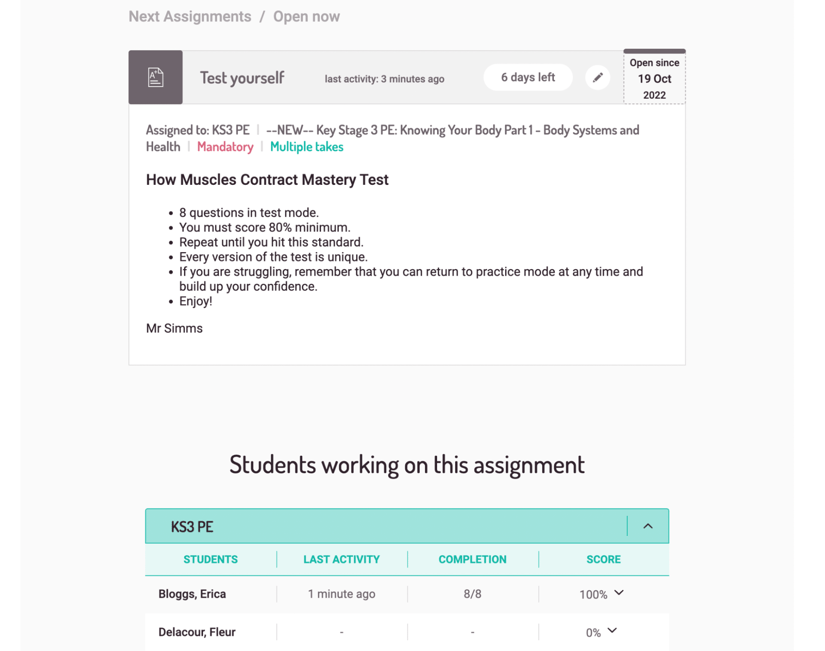
The quiz mastery assignment that one student has completed and another not yet.
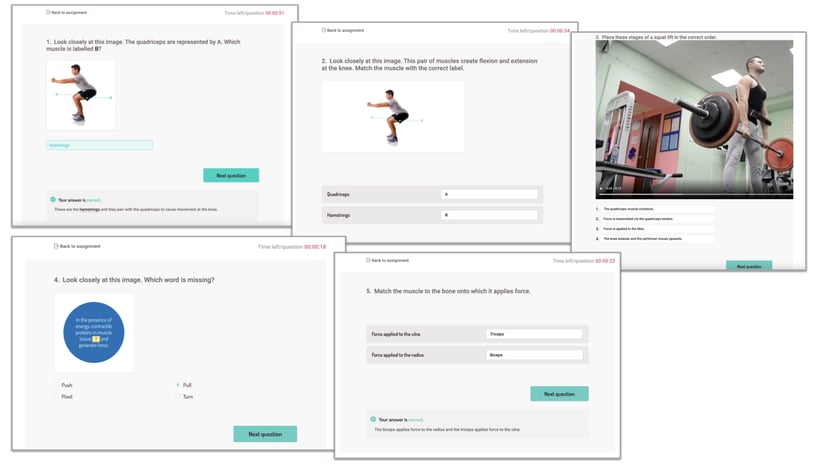
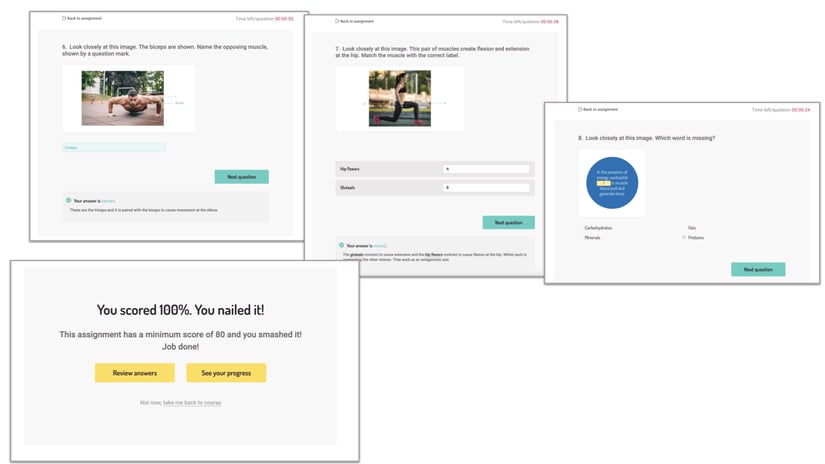
A run of eight questions that a student received. Please note that every quiz iteration is unique.
Activity 1: Warm-up
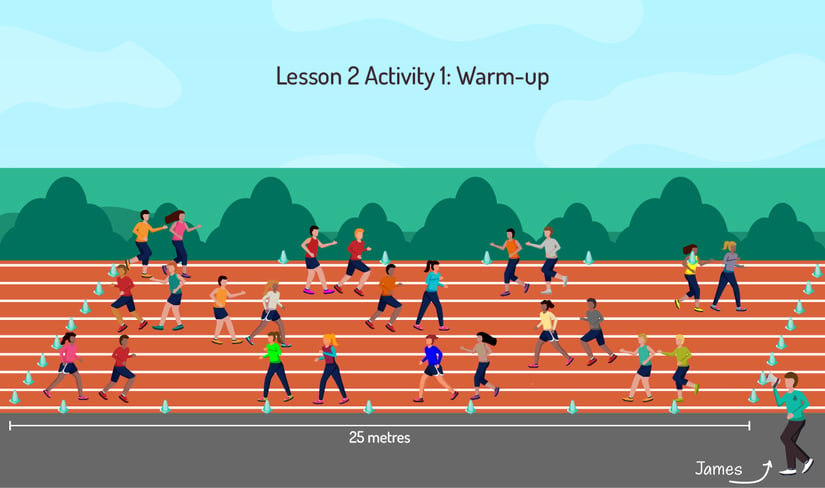
- Follow the command within the working area.
- Truck and trailer within the working area.
Activity 2: Group circular sprinting
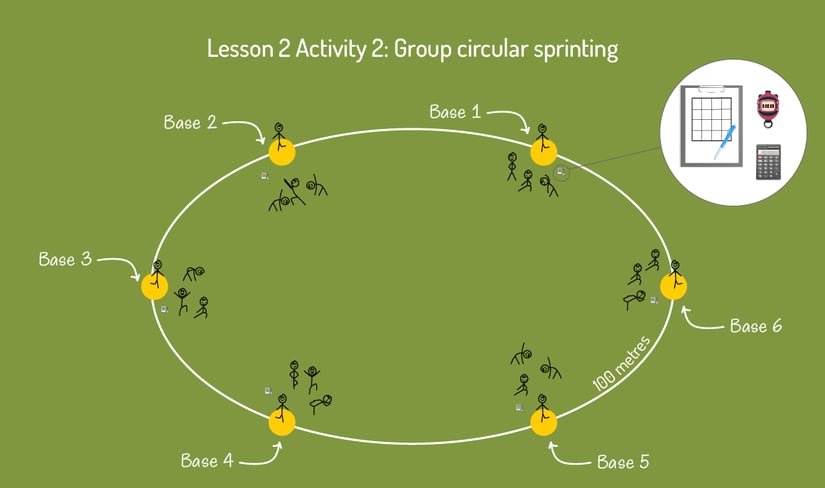
- Your space should be an oval of approximately 100m circumference.
- Establish six bases on the inside of the track equidistant from one another.
- Separate the group into fours and position a group of four at each base.
- Each base has a stopwatch, clipboard, recording sheet, pen and calculator.
- Give the students this very clear instruction: “Only step onto the course when you are fully ready to run.”
- Each student has three attempts at running the full track and records their time.
- Once all twelve runs are done, ensure the groups have calculated the median times and have ranked the group members from 1-4.
Debrief
Either before, during or after the activity above, teach the following:- Acceleration technique as taught in the last lesson.
- Bend-running variation, such as leaning in, shorter shoulder circle on inside arm, tilt head in slightly, slightly lower knee lift on inside leg. There is an opportunity here to teach the intuition of angular momentum but this should be done cautiously and only if the opportunity presents itself.
Activity 3: New group races
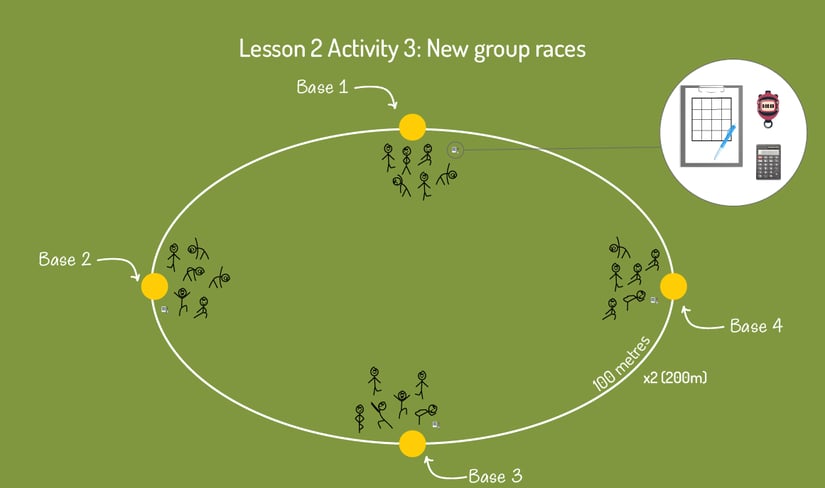
- Separate the groups into group 1-4 based on the previous rankings. Each group will have six members.
- Each group must run a 200m time trial three times. The time trial is timed as the time taken for the penultimate runner to cross the line. This means the fifth-placed runner. This is the time for the group. Encourage the group to work together to make this time trial time as fast as possible and to improve the time on subsequent attempts.
- Ask the group to calculate the class median time across the four groups.
Activity 4: Whole-group 800m challenge
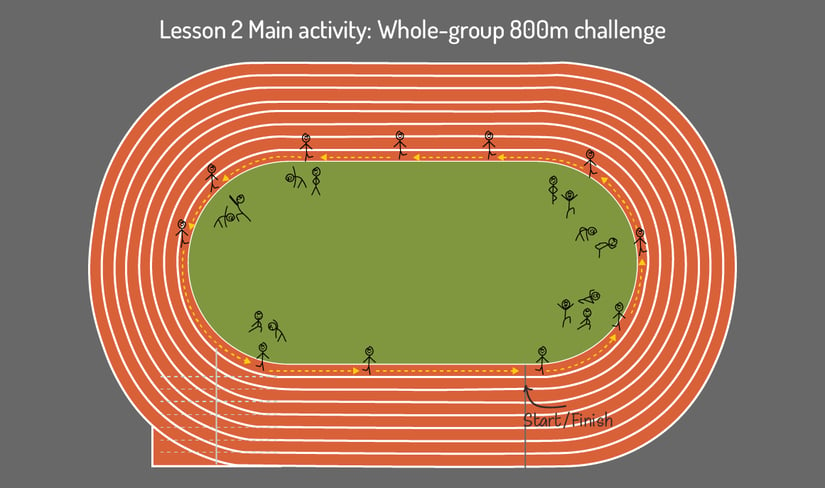
- Bring the group together and discuss the differences between their 800m challenge from last week and their sprinting times from this week. In essence, the median time from this week multiplied by 8 is their potential best time for the 800m.
- Challenge the group to carry the baton as close to that time as possible and to find ways to minimise the losses in time at changeovers, etc.
Debrief
- Bring the group together and discuss the activity.
- Introduce muscle contractions to them from their pre-lesson learning. Ask them:
- How has force been generated to move them so fast? (contractile proteins in muscles - opportunity to link to protein knowledge)
- When muscles contract, how do they transfer force to the bones? (role of tendons)
- What is muscle tissue made of? How did this get there? (muscle tissue is protein filament and is delivered from amino acids extracted from protein-rich foods)
- These questions should help you to link muscle contractions back to proteins from last lesson.
Cool-down and stretch
Conclusions
Well, firstly, what do you think? I was happy with the lessons overall but, as always, there were areas for improvement. I did reflect on the following points specifically:
- The priorities of my lesson were broader than I would typically plan for in a practical PE setting. I enjoyed this aspect of the planning, as I have always taken the opportunity to educate as broadly as possible.
- My teaching of the non-movement ideas has become more structured than my previous experiences, where I had a more informal and spontaneous style of teaching these ideas. This has been facilitated by the availability of the KS3 courses on TheEverLearner.com. This makes me wonder what might be the impact if, via TheEverLearner.com, there were courses on “everything” that could be learned through movement.
- Working within this format, I was better able to extract examples from the students through Q&A than I have in the past. This was because the students had pre-studied material on proteins (lesson one) and on muscular contraction (lesson two).
- Homework for KS3 PE students is appropriate as long as that homework relates to the PE lesson experiences. I am now more convinced of this than ever. I really hope that colleagues may challenge me on this point as a discussion would be positive.
- The subject of PE is better positioned than most other subjects to educate young people broadly. This is because, amongst other reasons, it has the following characteristics:
- It is physical as well as cognitive.
- It is applied and real.
- It occurs in a wider array of spaces than just in the classroom.
- It requires cooperation intrinsically.
- It requires taking more risks than in most classroom situations.
- It develops character implicitly.
Now, PE is not unique in this way. Any subject can and - arguably - should be learned via movement. The reality is, though, that students spend almost their entire learning day in school sitting down in classrooms. Therefore, PE is uniquely positioned as, currently, the only subject that has a culture of educating holistically.
- Good planning makes group structures relevant. Take my two lessons as an example: it is meaningful how the group is structured and subdivided. Breaking students into sub-groups has meaning and needs to be done deliberately and cautiously because of the nature of the activities.
- I would like to improve the group restructuring that occurred in lesson 2 activity 3. Whilst this restructure is not meant as a ranking, in essence, it ends up this way. I know my groups and I can ensure that the “feeling” of the lesson is appropriate but this type of reorganisation can have a negative impact. I would be keen to read what other PE teachers might have done instead.
So, there you have it: two lessons taught by me and available for you to review and comment on. I look forward to receiving your feedback.
Have a great day.
%20Text%20(Violet).png)
